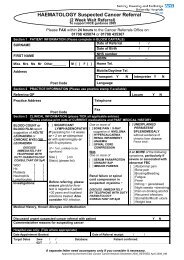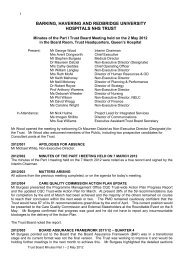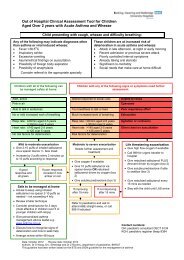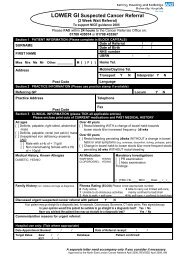Varicocele embolisation leaflet - Queen's Hospital
Varicocele embolisation leaflet - Queen's Hospital
Varicocele embolisation leaflet - Queen's Hospital
You also want an ePaper? Increase the reach of your titles
YUMPU automatically turns print PDFs into web optimized ePapers that Google loves.
and the interventional radiologist and radiology<br />
nurse will wear sterile gowns and gloves. The skin<br />
near the point of insertion, usually the groin but<br />
occasionally the neck, will be swabbed with<br />
antiseptic and you will be covered with sterile<br />
drapes.<br />
The skin and deeper tissues over the vein will be<br />
numbed with local anaesthetic, and then a fine tube<br />
(catheter) will be inserted and guided, using the<br />
X-ray equipment, into position down the vein<br />
(testicular vein), which takes blood away from the<br />
testis. The interventional radiologist will block this<br />
vein usually by inserting small metal coils, which<br />
look like springs and will remain in the abnormal<br />
vein.<br />
The radiologist will inject small amounts of dye<br />
(contrast agent) to check the position of the<br />
catheter and that the abnormal veins are blocked<br />
satisfactorily. Once they are blocked, the catheter<br />
will be removed. The interventional radiologist<br />
will press firmly on the skin entry point for a few<br />
minutes to prevent any bleeding.<br />
Will it hurt?<br />
When the local anaesthetic is injected, it will sting<br />
for a short while, but this soon wears off. You may<br />
have a small bruise after the procedure. You may<br />
feel a warm sensation for a few seconds when the<br />
dye is injected and feel like you are passing urine.<br />
After this, the procedure should not be painful.<br />
How long will it take?<br />
Every patient is different, and it is not always easy<br />
to predict; however, expect to be in the radiology<br />
department for about an hour.<br />
What happens afterwards?<br />
You will be taken back to your ward. Nursing staff<br />
will carry out routine observations including pulse<br />
and blood pressure and will also check the<br />
treatment site.<br />
You will generally stay in bed for a couple of<br />
hours and then you will be able to go home. Take it<br />
easy for the rest of the day but you can resume<br />
normal activities the next day.<br />
Barking, Havering & Redbridge<br />
University <strong>Hospital</strong>s NHS Trust<br />
The Radiology Department<br />
Queen’s <strong>Hospital</strong><br />
Useful Telephone Numbers:<br />
X-Ray- 01708 435000 ext 3256<br />
Or 01708 435301<br />
(Monday to Friday 08.45 – 17.00 hrs)<br />
0845 130 4204<br />
(For use outside of the above hours)<br />
www.bhrhospitals.nhs.uk<br />
This <strong>leaflet</strong> is a guide as to what is entailed in<br />
this examination and the possible risks and<br />
benefits of having this exam will be discussed<br />
by the radiologist taking your consent.<br />
Information from the British Society of<br />
Interventional Radiology (BSIR) and the<br />
Clinical Radiology Patients’ Liaison Group<br />
(CRPLG) of the Royal College of<br />
Radiologists has been used in this <strong>leaflet</strong>.<br />
If you do not see or hear clearly and<br />
require additional assistance, the Patient<br />
Advice and Liaison Service will be happy<br />
to help.<br />
PALS OFFICE<br />
24 hour answer phone<br />
0800 389 8324<br />
Updated January 2012<br />
Revision date 2014<br />
PI 121<br />
DEPARTMENT OF<br />
INTERVENTIONAL RADIOLOGY<br />
VARICOCELE<br />
EMBOLISATION<br />
An information <strong>leaflet</strong> for<br />
patients and carers
What is a <strong>Varicocele</strong><br />
Embolisation?<br />
A varicocele is an abnormality of the<br />
veins that take blood away from the testis.<br />
The valves in the veins do not work<br />
properly and so the veins become bigger<br />
and more obvious, rather like varicose<br />
veins in the leg. Embolisation is an X-ray<br />
guided treatment, which blocks the<br />
enlarged vein from the testis typically<br />
using a spring (a coil) and allows the<br />
veins to shrink.<br />
Why do you need an Embolisation?<br />
A varicocele can cause discomfort in the<br />
scrotum, which is often worse when<br />
standing, exercising or cycling. They are<br />
sometimes diagnosed during the<br />
investigation of infertility and treatment<br />
may help your sperm count. There are a<br />
number of ways to treat varicoceles<br />
including open groin surgery,<br />
laparoscopic surgery and minimally<br />
invasive interventional radiology.<br />
Interventional radiology uses X-rays to<br />
guide a small tube to the vein to block it<br />
with only a small 3–4 mm incision in the<br />
groin. It is performed as a day case<br />
procedure.<br />
Are there any risks?<br />
<strong>Varicocele</strong> <strong>embolisation</strong> is a very safe<br />
procedure, but as with any medical<br />
procedure there are some risks and<br />
complications that can arise. There<br />
may occasionally be a small bruise called a haematoma<br />
around the site where the needle has been inserted into<br />
the vein. This will go away in a week or two.<br />
A few patients may experience mild discomfort in the<br />
loin or scrotum afterwards which rarely lasts more<br />
than a few days.<br />
There is a very small risk of a coil, used to occlude the<br />
vein, could migrate to your lungs. If this happens and<br />
it cannot be retrieved it is very unlikely to cause any<br />
problems other than a cough and mild chest pain for a<br />
few days.<br />
Rarely, it may not be possible to obtain a satisfactory<br />
position for <strong>embolisation</strong>, in which case a surgical<br />
operation may be offered.<br />
Unfortunately, there is a possibility that the varicocele<br />
may come back again. This may also happen after any<br />
surgical treatment. If this happens, then the procedure<br />
may be repeated, or you may be advised to have an<br />
operation.<br />
Who has made the decision?<br />
The consultant in charge of your care, normally a<br />
surgeon or infertility expert, and the interventional<br />
radiologist performing the procedure have discussed<br />
your case and feel that this is the best option.<br />
However, you will also have the opportunity for your<br />
opinion to be considered and if, after discussion with<br />
your doctors, you no longer want the procedure, you<br />
can decide against it.<br />
Are you required to make any special<br />
preparations?<br />
Varicocle <strong>embolisation</strong> is usually carried out as a day<br />
case procedure under local anaesthetic. You may be<br />
asked not to eat for four hours before the procedure,<br />
although you may still drink clear fluids such as water.<br />
If you have any allergies or have previously<br />
had a reaction to the dye (contrast agent), you<br />
must tell the radiology staff before you have<br />
the test.<br />
Who will you see?<br />
A specially trained team led by an<br />
interventional radiologist within the radiology<br />
department. Interventional radiologists have<br />
special expertise in reading the images and<br />
using imaging to guide catheters and wires to<br />
aid diagnosis and treatment.<br />
Where will the procedure take place?<br />
In the angiography suite or theatre; this is<br />
usually located within the radiology<br />
department. This is similar to an operating<br />
theatre into which specialised X-ray<br />
equipment has been installed.<br />
What happens during <strong>embolisation</strong>?<br />
Before the procedure, the interventional<br />
radiologist will explain the procedure and ask<br />
you to sign a consent form. Please feel free to<br />
ask any questions that you may have and,<br />
remember that even at this stage, you can<br />
decide against going ahead with the procedure<br />
if you wish.<br />
You will be asked to get undressed and put on<br />
a hospital gown. A small cannula (thin tube)<br />
will be placed into a vein in your arm.<br />
You will lie on the X-ray table, generally flat<br />
on your back. A needle will be inserted into a<br />
vein in your arm, so that a sedative or painkillers<br />
can be given if required. You may have<br />
monitoring devices attached to your chest and<br />
finger and may be given oxygen. The procedure<br />
is performed under sterile conditions


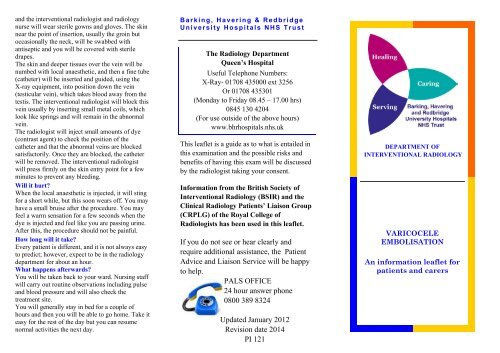
![[4] Biopsy Leaflet.pub - Barking, Havering and Redbridge University ...](https://img.yumpu.com/51285530/1/190x134/4-biopsy-leafletpub-barking-havering-and-redbridge-university-.jpg?quality=85)

